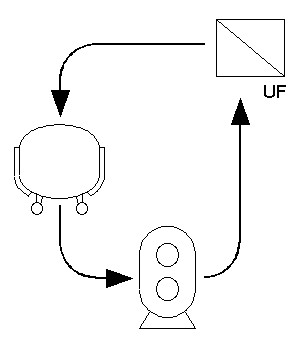Direct Flow Filtration
Direct flow filtration (aka. "dead end filtration") refers to any filtration operation in which the feed liquid is passed straight through the filtration media. Impurities are retained in the media. In prinicple, this is similar to removing sand from water by passing it through a cloth, except that in biopharmaceutical manufacturing, the particulates are often the cells and cell debris from the bioreactor. The two basic types of filter media are:
- Depth media - This type of filter has a significant capacity to contain the removed solids while maintaining some flow. A common type consists of filter cartridges containing diatomaceous earth.
- Membrane-based media - Although providing much lower capacity for foulants, this type of filter has much better defined retention characteristics. It can be used to remove potential bacterial contamination.
Cross Flow Filtration

Diagram of a typical cross-flow filtration process.
Cross Flow filtration is an operation in which the major flow of feed liquid runs across (not through) the membrane, with a relatively small fraction permeating through the membrane on each pass. What this does is to scrub the membrane with the liquid flowing across its surface to avoid the plugging of pores in the membrane.